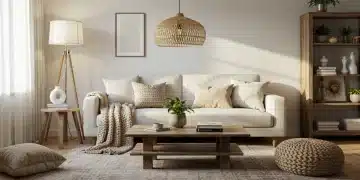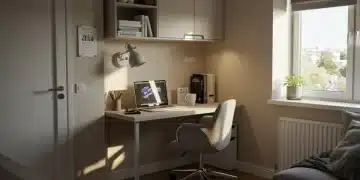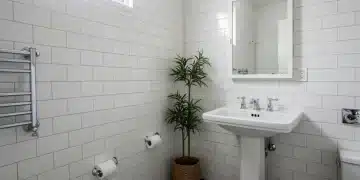Living Room Update: 5 Hottest Interior Design Trends for 2025

The 2025 interior design landscape for living rooms is characterized by a blend of sustainability, smart technology integration, and personalized comfort, moving towards spaces that are both functional and deeply reflective of individual lifestyles.
Are you ready to refresh your living space? The world of interior design is constantly evolving, and 2025 promises exciting shifts in how we conceptualize and utilize our most communal home areas. This article will delve into the living room design trends that are set to dominate next year, offering insights and inspiration to transform your home into a stylish sanctuary.
Embracing Sustainable and Biophilic Design
The conscious consumer movement continues to profoundly influence interior design, with sustainability and biophilia taking center stage in living room aesthetics for 2025. This trend goes beyond mere aesthetics, advocating for spaces that are not only beautiful but also environmentally responsible and conducive to well-being.
Designers are increasingly prioritizing materials that are recycled, upcycled, or ethically sourced, reducing the carbon footprint of home decor. This commitment extends to the entire lifecycle of a product, from its creation to its eventual disposal. The focus is on longevity and timelessness, moving away from fast-furniture culture towards pieces that are built to last and can adapt to evolving styles.
The Rise of Natural Materials and Textures
Expect to see an abundance of natural materials gracing living rooms. Think untreated wood, rattan, bamboo, cork, and natural fibers like linen, organic cotton, and jute. These materials bring an inherent warmth and texture to a space, creating an inviting and grounded atmosphere. Their imperfections are celebrated, adding character and a sense of authenticity that mass-produced items often lack.
- Wood: Light-toned, natural wood finishes for furniture, flooring, and decorative elements.
- Stone: Travertine, marble, and slate used for coffee tables, side tables, and decorative objects.
- Textiles: Organic cotton, hemp, and wool for upholstery, throws, and rugs, emphasizing tactile comfort.
- Ceramics: Hand-crafted pottery and ceramic pieces in earthy tones, adding an artisanal touch.
Integrating Greenery and Natural Elements
Biophilic design, which seeks to connect occupants with nature, is more vital than ever. Living rooms in 2025 will feature an increased integration of indoor plants, natural light, and organic shapes. This approach aims to reduce stress, improve cognitive function, and enhance overall mood by bringing the outdoors in. Large, leafy plants, living walls, and even indoor water features can contribute to this serene environment.
Beyond plants, consider elements like natural light maximization through sheer curtains or strategic window placement, and the use of natural patterns inspired by flora and fauna in textiles or artwork. The goal is to create a harmonious balance between the built environment and the natural world, transforming living rooms into calming retreats.
In essence, sustainable and biophilic design for 2025 living rooms is about creating spaces that feel good, do good, and look effortlessly stylish. It’s a holistic approach that considers both the aesthetic and ecological impact of our design choices, paving the way for healthier and more mindful homes.
The Rise of Smart Home Integration and Tech-Enhanced Comfort
As technology becomes increasingly seamless in our daily lives, its integration into living room design is evolving beyond mere gadgets to create truly intuitive and comfortable spaces. In 2025, smart home technology will be less about visible devices and more about invisible functionality, enhancing convenience, efficiency, and ambiance without cluttering the aesthetic.
The focus is on creating a connected environment where lighting, temperature, entertainment, and even security can be controlled effortlessly, often through voice commands or subtle gestures. This trend emphasizes user experience, making technology an integral, yet unobtrusive, part of the living room’s overall design and functionality.
Seamless Smart Lighting Systems
Smart lighting will be a cornerstone of tech-enhanced living rooms. Beyond simple on/off functions, these systems will offer dynamic control over color temperature and intensity, allowing homeowners to create different moods for various activities – from bright task lighting to warm, ambient glow for relaxation. Integration with circadian rhythm programming will also become more prevalent, adjusting light levels to support natural sleep-wake cycles.
- Adaptive Lighting: Systems that automatically adjust based on natural light levels or time of day.
- Mood Zones: Pre-set lighting scenes for entertaining, reading, or watching movies.
- Voice Control: Integration with popular smart assistants for hands-free operation.
- Hidden Fixtures: Recessed lighting, LED strips, and smart bulbs that blend seamlessly into the architecture.
Integrated Entertainment and Sound Solutions
The days of bulky speakers and visible cables are giving way to discreet, high-performance entertainment systems. Soundbars integrated into furniture, in-wall or in-ceiling speakers, and projectors that retract when not in use will define the media experience. The goal is cinematic quality without visual intrusion, maintaining a clean and sophisticated aesthetic.
Smart televisions that double as art when off, or even mirror-TVs, will further blur the lines between technology and decor. These advancements ensure that the living room remains a focal point for relaxation and social interaction, rather than a mere tech hub.
Ultimately, tech-enhanced comfort in 2025 living rooms is about creating an environment that responds to our needs intuitively, making daily life simpler and more enjoyable. It’s about technology serving design, rather than dominating it, ensuring that our spaces are both cutting-edge and deeply comfortable.
Modular and Multifunctional Furniture for Flexible Living
As living spaces become more dynamic and often smaller, the demand for furniture that offers versatility and adaptability is soaring. For 2025, modular and multifunctional furniture pieces will be essential in living rooms, providing homeowners with the flexibility to reconfigure their spaces to suit various activities and changing needs throughout the day.
This trend reflects a shift towards more practical and adaptable interiors, where a single piece of furniture can serve multiple purposes, optimizing space and promoting a more fluid lifestyle. It’s about smart design solutions that empower individuals to personalize their environment on demand.
The Appeal of Modular Sofas and Sectionals
Modular sofas are perhaps the quintessential example of this trend. Composed of individual sections that can be rearranged, they offer endless possibilities for customization. Whether you need a large L-shaped sectional for movie nights, a symmetrical arrangement for formal entertaining, or individual chairs for intimate conversations, modular pieces can adapt.
- Customizable Layouts: Easily reconfigure to suit different social gatherings or personal preferences.
- Integrated Storage: Many modular units come with hidden storage compartments, perfect for decluttering.
- Versatile Seating: Individual sections can serve as ottomans, chaises, or standalone chairs.
- Long-term Value: Adaptable to future living situations, making them a sustainable investment.
Multifunctional Coffee Tables and Storage Solutions
Beyond seating, other furniture pieces are also embracing multifunctionality. Coffee tables that transform into dining tables, ottomans that offer concealed storage, and shelving units that double as room dividers are becoming increasingly popular. These items are designed to maximize utility without compromising on style.
The key is clever design that integrates storage and multiple functions seamlessly, often with minimalist aesthetics to maintain a clean and uncluttered look. This approach is particularly beneficial for urban dwellers or anyone seeking to make the most of limited square footage, proving that good design can enhance both form and function.
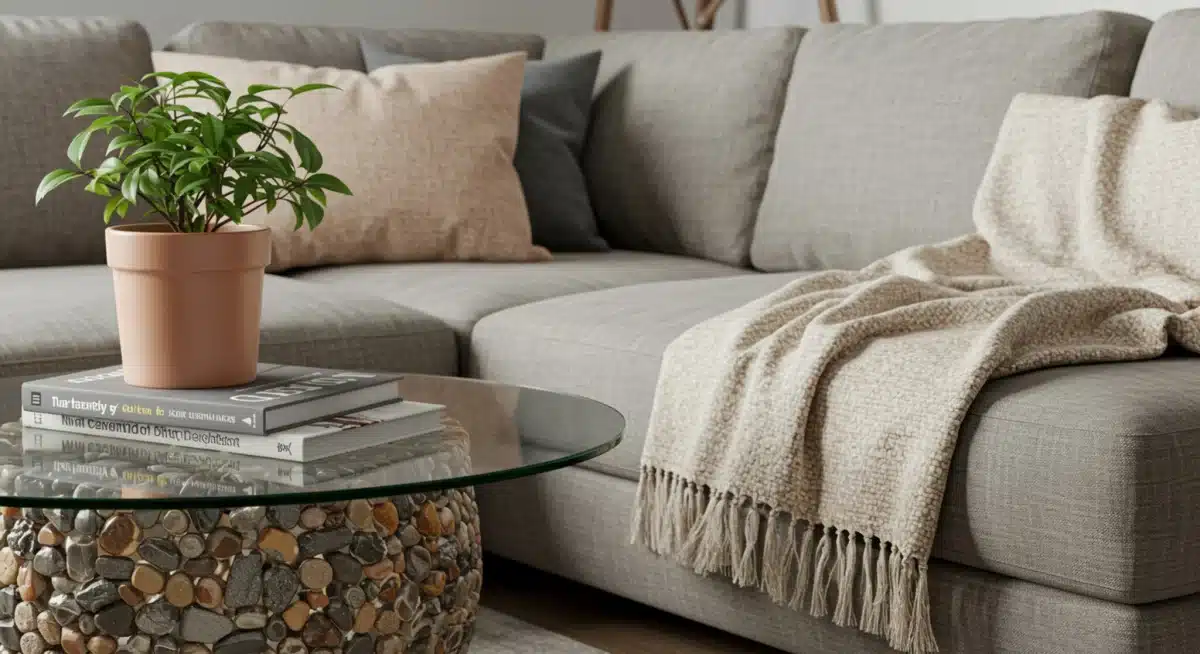
Ultimately, modular and multifunctional furniture empowers homeowners to create living rooms that are not only stylish but also highly practical and responsive to the dynamic rhythms of modern life. It’s about designing for flexibility, ensuring that our spaces can effortlessly evolve with us.
Personalized Expression and Curated Eclecticism
Moving away from rigid, prescriptive design rules, 2025 living rooms will celebrate personalized expression and curated eclecticism. This trend encourages homeowners to infuse their spaces with unique stories, treasured objects, and a mix of styles that truly reflect their individuality and experiences.
It’s about creating a living room that feels authentic and lived-in, rather than a showroom. This approach embraces imperfections, combines old with new, and allows for a rich tapestry of textures, colors, and patterns, resulting in spaces that are deeply personal and full of character.
Mixing Eras and Styles with Confidence
The art of mixing and matching different design eras and styles will be perfected in 2025. A vintage mid-century modern credenza might sit comfortably alongside a contemporary minimalist sofa, complemented by an antique rug. The key is to find common threads—be it color palette, material, or a particular aesthetic—to ensure cohesion amidst diversity.
- Vintage Finds: Incorporating unique antique or thrifted pieces that tell a story.
- Art and Collectibles: Displaying personal art collections, travel souvenirs, and cherished objects.
- Global Influences: Blending design elements from different cultures to create a worldly feel.
- Layered Textures: Combining various fabrics, weaves, and finishes for depth and warmth.
The Importance of Personal Narrative
Every item in a curated eclectic living room should have a reason for being there, contributing to the homeowner’s personal narrative. This could be a piece of art from a memorable trip, a handcrafted item from a local artisan, or a family heirloom. These elements transform a house into a home, imbuing it with soul and authenticity.
Color palettes will also become more adventurous, moving beyond neutral safety to embrace bold hues and unexpected combinations that reflect personality. The aim is to create a space that evokes emotion and sparks conversation, becoming a true reflection of those who inhabit it.
In essence, personalized expression and curated eclecticism for 2025 living rooms are about breaking free from conventional design norms. It’s an invitation to be bold, be authentic, and create a living space that is uniquely and beautifully yours, celebrating your journey and your passions.
Bold Colors and Statement Pieces
After years of muted palettes and minimalist tendencies, 2025 is ushering in an era of bold colors and unapologetic statement pieces in living rooms. This trend is a celebration of individuality and a desire to create spaces that are vibrant, energetic, and visually captivating. It’s about injecting personality and drama through strategic use of color and impactful design elements.
Homeowners are becoming more confident in experimenting with rich, saturated hues and selecting furniture or decor items that serve as focal points, sparking conversation and defining the room’s character. This move signifies a departure from understated elegance towards a more expressive and confident aesthetic.
Embracing Rich, Saturated Color Palettes
Expect to see living rooms awash in deeper, more complex color schemes. Jewel tones like emerald green, sapphire blue, and ruby red will make a strong comeback, often paired with earthy neutrals or complementary metallics. Warm, inviting shades such as terracotta, mustard yellow, and deep plum will also gain prominence, creating cozy yet luxurious environments.
- Accent Walls: A single wall painted in a bold color to create a dramatic backdrop.
- Velvet Upholstery: Sofas and armchairs in rich, colorful velvet fabrics for a touch of opulence.
- Patterned Rugs: Large area rugs featuring intricate patterns and vibrant color combinations.
- Art and Accessories: Incorporating colorful artwork, vases, and cushions to add pops of color.
The Allure of Statement Furniture and Art
A single, well-chosen statement piece can transform an entire living room. This could be an oversized sofa in an unexpected color, a sculptural coffee table, or a dramatic piece of contemporary art. These elements are designed to draw the eye and serve as the room’s defining feature, reflecting the homeowner’s distinctive taste.
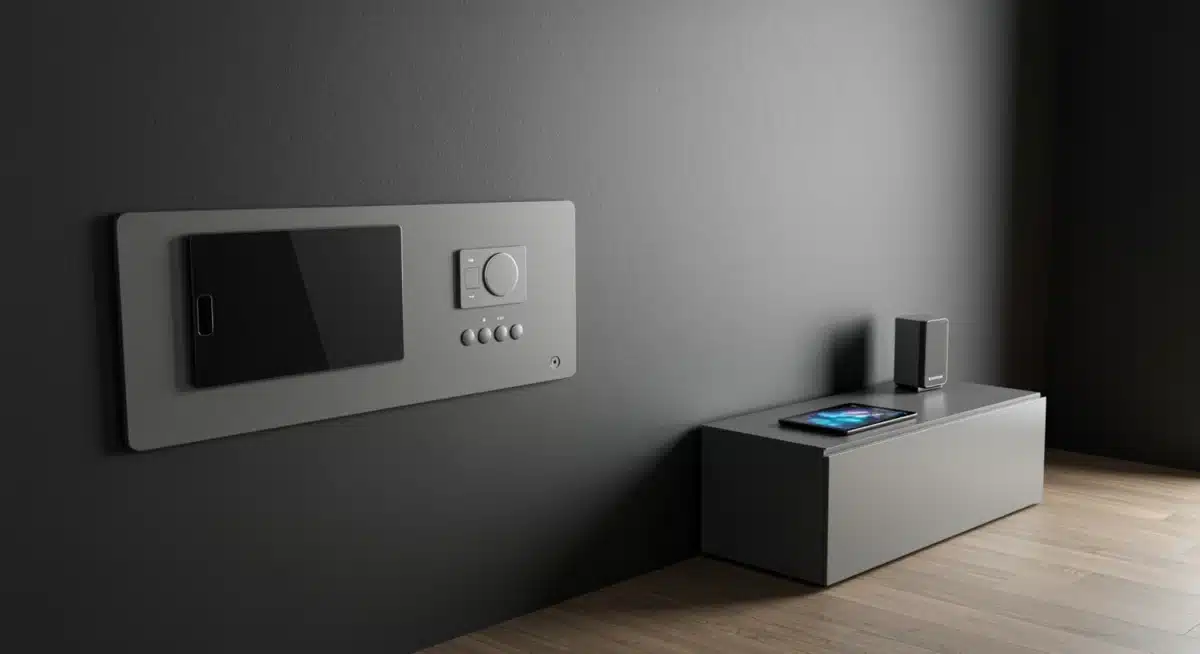
The idea is not to overwhelm the space but to create strategic focal points that elevate the overall design. These pieces often boast unique shapes, textures, or materials, making them true works of art in their own right. They break monotony and add a layer of sophistication and intrigue.
Ultimately, bold colors and statement pieces in 2025 living rooms are about creating spaces that are memorable, energetic, and deeply personal. It’s an invitation to be daring with design, crafting an environment that truly expresses joy and confidence.
Wellness-Focused Design and Comfort Zones
The living room in 2025 is increasingly viewed as a sanctuary—a space dedicated to relaxation, rejuvenation, and overall well-being. This trend, often termed wellness-focused design, prioritizes comfort, tranquility, and elements that contribute to mental and physical health. It’s about creating an environment that actively supports a balanced lifestyle.
This approach goes beyond mere aesthetics, integrating principles that enhance calm and reduce stress. From ergonomic furniture to soothing color palettes and sensory experiences, every element is chosen with the occupant’s well-being in mind, transforming the living room into a true comfort zone.
Creating Dedicated Comfort Nooks
The concept of a ‘comfort nook’ or ‘hygge corner’ will become more defined. These are dedicated small spaces within the living room designed for specific relaxation activities, such as reading, meditation, or simply unwinding. They often feature an exceptionally comfortable armchair or chaise, soft lighting, and personal touches.
- Reading Corners: A plush armchair, a floor lamp with warm light, and a small side table for a cup of tea.
- Meditation Zones: A comfortable cushion, subtle aromatherapy diffuser, and calming artwork.
- Window Seats: Built-in seating by a window, adorned with soft cushions and throws, perfect for contemplation.
- Cozy Textiles: Abundant use of soft blankets, throws, and pillows in varied textures.
Sensory Elements for Enhanced Well-being
Wellness-focused design engages all the senses to create a harmonious environment. This includes incorporating elements that appeal to touch, sight, smell, and even sound.
Consider materials like cashmere or faux fur for throws, aromatherapy diffusers with calming essential oils, and the subtle sounds of a water feature or ambient music. Natural light, as discussed in biophilic design, also plays a crucial role in regulating mood and energy levels. The goal is to create a holistic sensory experience that promotes peace and relaxation.
Ultimately, wellness-focused design for 2025 living rooms is about crafting spaces that nurture the soul and provide a much-needed escape from the stresses of modern life. It’s an investment in personal health and happiness, ensuring our homes are truly places of comfort and restoration.
Art Deco Revival with a Modern Twist
The timeless elegance and luxurious appeal of Art Deco are making a significant comeback in 2025 living room trends, but with a fresh, contemporary interpretation. This revival merges the iconic geometric patterns, opulent materials, and sophisticated silhouettes of the 1920s and 30s with modern sensibilities, resulting in spaces that are both glamorous and functional.
This trend is characterized by a balance of grandeur and restraint, avoiding overt historical mimicry in favor of a refined, updated aesthetic. It’s about incorporating key Art Deco elements in a way that feels relevant and chic for today’s homes, adding a touch of vintage glamour without feeling dated.
Key Art Deco Elements Reimagined
Expect to see classic Art Deco motifs like sunburst patterns, stepped designs, and fan shapes integrated into modern furniture and decor. Materials such as polished chrome, brass, and lacquered finishes will be combined with rich velvets, exotic woods, and mirrored surfaces, creating a sense of luxury and sophistication. The color palette often features deep jewel tones, metallics, and classic black and white.
- Geometric Patterns: Used in wallpaper, rugs, and decorative details.
- Metallic Accents: Brass, gold, and chrome on furniture legs, lighting fixtures, and accessories.
- Rich Fabrics: Velvet, satin, and silk for upholstery and drapery, adding a tactile luxury.
- Streamlined Silhouettes: Furniture with clean lines and rounded edges, reflecting the era’s sleekness.
Achieving a Modern Art Deco Aesthetic
The modern twist on Art Deco involves a less-is-more approach. Instead of filling the room with period pieces, designers will select a few impactful items that evoke the era’s spirit. This could be a statement bar cart, a stunning chandelier, or a console table with a geometric inlay. The goal is to create an atmosphere of refined elegance rather than a themed room.
Pairing these glamorous elements with contemporary minimalist pieces or natural textures can prevent the space from feeling overly ornate. The contrast between the old-world luxury of Art Deco and the simplicity of modern design creates a sophisticated and intriguing balance.
In conclusion, the Art Deco revival with a modern twist for 2025 living rooms offers a unique opportunity to infuse spaces with historical grandeur and refined luxury. It’s about celebrating a bygone era’s elegance while ensuring the design remains fresh, functional, and perfectly suited for contemporary living.
| Key Trend | Brief Description |
|---|---|
| Sustainable & Biophilic | Focus on eco-friendly materials, natural elements, and indoor plants for well-being. |
| Smart Home Integration | Seamless tech for lighting, entertainment, and comfort, enhancing functionality discreetly. |
| Modular & Multifunctional | Flexible furniture pieces that adapt to various needs and optimize space. |
| Personalized Eclecticism | Mixing styles and curated items to reflect individual stories and unique tastes. |
Frequently Asked Questions About 2025 Living Room Trends
▼
The most significant overarching theme for 2025 living room design is a blend of conscious living and personalized expression. This encompasses sustainability, biophilic elements, and smart technology while emphasizing unique styles that reflect individual personalities and well-being.
▼
You can start by integrating smaller sustainable elements like indoor plants, opting for natural fiber textiles (organic cotton, linen, hemp), choosing furniture made from reclaimed wood, or investing in vintage pieces. Prioritize durable, high-quality items over disposable ones to reduce waste.
▼
No, the trend for 2025 is towards seamless and discreet integration of smart home technology. Expect hidden speakers, smart lighting that blends into architecture, and voice-controlled systems that enhance convenience without cluttering the visual aesthetic. The focus is on invisible functionality.
▼
2025 living rooms will embrace bold and saturated color palettes. Jewel tones like emerald green and sapphire blue, warm earthy shades such as terracotta and mustard yellow, and rich plums are gaining popularity. These colors add personality and energy, moving beyond strictly neutral schemes.
▼
Wellness-focused design prioritizes comfort and ergonomics in furniture. This means selecting plush, inviting seating, creating dedicated comfort nooks with cozy armchairs, and choosing materials that are soft and tactile. The aim is to foster relaxation and physical ease within the space.
Conclusion
The interior design landscape for living rooms in 2025 is an exciting fusion of sustainability, technological sophistication, and profound personal expression. From embracing the calming influence of biophilic elements and eco-conscious materials to the seamless integration of smart home technology, the focus is on creating spaces that are not only aesthetically pleasing but also highly functional and supportive of well-being. The resurgence of bold colors and the elegant twist on Art Deco, alongside the adaptability of modular furniture, underscore a desire for living rooms that truly reflect individual lifestyles and values. As we look ahead, the emphasis remains on crafting environments that are both beautiful and deeply resonant, transforming our homes into genuine sanctuaries for modern living.
